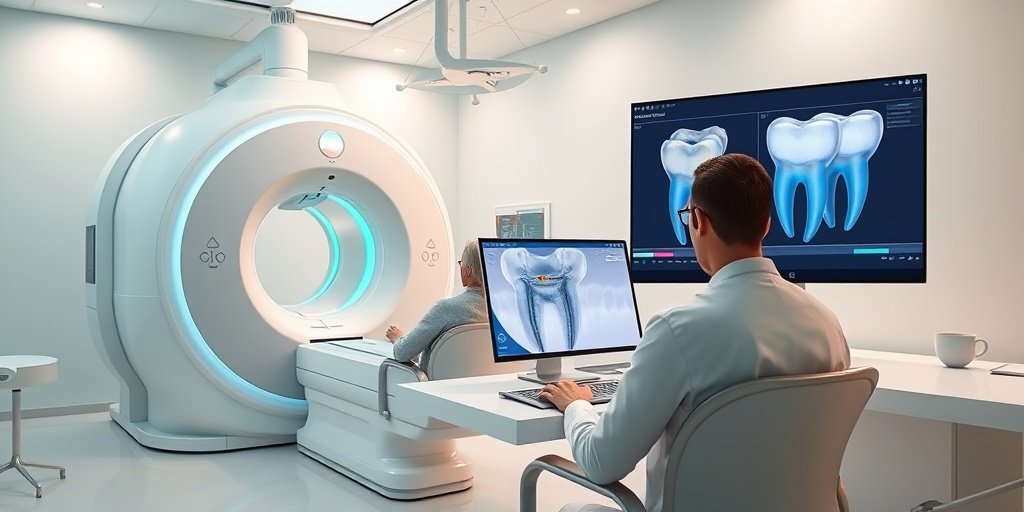⚡ Quick Summary
This study evaluated the accuracy and time efficiency of manual versus AI-driven tooth segmentation on cone-beam computed tomography (CBCT) images. The findings indicate that while AI methods significantly reduce segmentation time, manual segmentation remains slightly more accurate.
🔍 Key Details
- 📊 Dataset: 14 patients, 67 extracted teeth
- ⚙️ Technology: Two AI-driven tools and one manual method
- ⏱️ Segmentation Time: AI methods reduced time compared to manual segmentation
- 📏 Accuracy Metrics: Discrepancy ranged from 0.10 to 0.98 mm, mean RMS of 0.27 mm
🔑 Key Takeaways
- 🤖 AI-driven segmentation can produce reliable virtual 3D tooth models.
- ⏳ Time efficiency is significantly improved with AI methods.
- 📉 Manual segmentation showed less RMS deviation compared to AI methods (p < 0.05).
- 🦷 Tooth type did not significantly affect segmentation accuracy (p > 0.05).
- 🔍 Artifacts in restoration cases require further optimization of AI models.
- 🌟 Overall accuracy varied by region, with the apical portion of the root being the least accurate.

📚 Background
The integration of artificial intelligence in dental imaging is a growing field, particularly in enhancing the precision of tooth segmentation from CBCT images. Accurate segmentation is crucial for effective implant planning and restoration, as it directly impacts treatment outcomes. This study aims to compare traditional manual methods with AI-driven approaches to determine their respective efficiencies and accuracies.
🗒️ Study
Conducted with 14 patients who underwent CBCT scans, the study involved segmenting 67 extracted teeth using both manual and AI-driven tools. The researchers recorded the time taken for each method and compared the virtual models generated against reference models obtained from intraoral scans. This comprehensive approach allowed for a robust evaluation of segmentation accuracy and efficiency.
📈 Results
The results revealed that the discrepancy between AI-driven and manual segmentation methods ranged from 0.10 to 0.98 mm, with a mean RMS of 0.27 mm. Notably, manual segmentation yielded less deviation compared to both AI methods, indicating a slight edge in accuracy. However, both AI-driven methods significantly reduced segmentation time, showcasing their potential for practical applications in clinical settings.
🌍 Impact and Implications
The implications of this study are significant for the field of dentistry. By demonstrating that AI-driven segmentation can achieve accuracy comparable to manual methods while enhancing time efficiency, this research paves the way for broader adoption of AI technologies in dental practices. As AI continues to evolve, further improvements in segmentation accuracy, particularly in challenging cases with artifacts, will be essential for optimizing patient care.
🔮 Conclusion
This study highlights the promising role of artificial intelligence in dental imaging, particularly in tooth segmentation. While manual methods still hold a slight advantage in accuracy, the time-saving benefits of AI-driven approaches cannot be overlooked. Continued advancements in AI technology will likely lead to even greater accuracy and efficiency in dental procedures, ultimately improving patient outcomes. We encourage ongoing research in this exciting area!
💬 Your comments
What are your thoughts on the integration of AI in dental imaging? Do you believe it will transform the field? 💬 Share your insights in the comments below or connect with us on social media:
Accuracy and Time Efficiency of Artificial Intelligence-Driven Tooth Segmentation on CBCT Images: A Validation Study Using Two Implant Planning Software Programs.
Abstract
OBJECTIVES: To assess the accuracy and time efficiency of manual versus artificial intelligence (AI)-driven tooth segmentation on cone-beam computed tomography (CBCT) images, using AI tools integrated within implant planning software, and to evaluate the impact of artifacts, dental arch, tooth type, and region.
MATERIALS AND METHODS: Fourteen patients who underwent CBCT scans were randomly selected for this study. Using the acquired datasets, 67 extracted teeth were segmented using one manual and two AI-driven tools. The segmentation time for each method was recorded. The extracted teeth were scanned with an intraoral scanner to serve as the reference. The virtual models generated by each segmentation method were superimposed with the surface scan models to calculate volumetric discrepancies.
RESULTS: The discrepancy between the evaluated AI-driven and manual segmentation methods ranged from 0.10 to 0.98 mm, with a mean RMS of 0.27 (0.11) mm. Manual segmentation resulted in less RMS deviation compared to both AI-driven methods (CDX; BSB) (p < 0.05). Significant differences were observed between all investigated segmentation methods, both for the overall tooth area and each region, with the apical portion of the root showing the lowest accuracy (p < 0.05). Tooth type did not have a significant effect on segmentation (p > 0.05). Both AI-driven segmentation methods reduced segmentation time compared to manual segmentation (p < 0.05).
CONCLUSIONS: AI-driven segmentation can generate reliable virtual 3D tooth models, with accuracy comparable to that of manual segmentation performed by experienced clinicians, while also significantly improving time efficiency. To further enhance accuracy in cases involving restoration artifacts, continued development and optimization of AI-driven tooth segmentation models are necessary.
Author: [‘Ntovas P’, ‘Sirirattanagool P’, ‘Asavanamuang P’, ‘Jain S’, ‘Tavelli L’, ‘Revilla-León M’, ‘Galarraga-Vinueza ME’]
Journal: Clin Oral Implants Res
Citation: Ntovas P, et al. Accuracy and Time Efficiency of Artificial Intelligence-Driven Tooth Segmentation on CBCT Images: A Validation Study Using Two Implant Planning Software Programs. Accuracy and Time Efficiency of Artificial Intelligence-Driven Tooth Segmentation on CBCT Images: A Validation Study Using Two Implant Planning Software Programs. 2025; (unknown volume):(unknown pages). doi: 10.1111/clr.70003